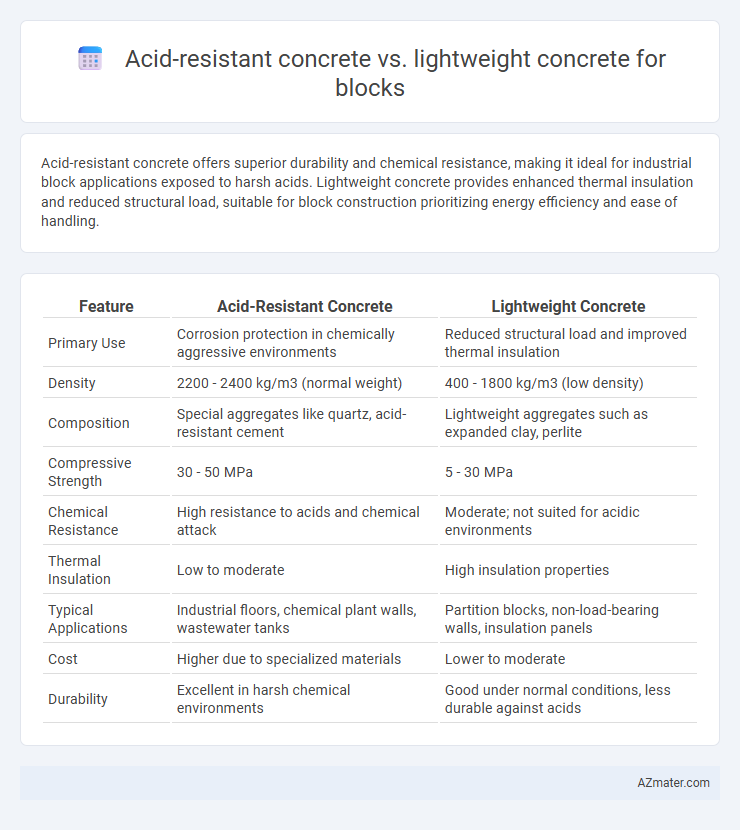Acid-resistant concrete offers superior durability and chemical resistance, making it ideal for industrial block applications exposed to harsh acids. Lightweight concrete provides enhanced thermal insulation and reduced structural load, suitable for block construction prioritizing energy efficiency and ease of handling.
Table of Comparison
| Feature | Acid-Resistant Concrete | Lightweight Concrete |
|---|---|---|
| Primary Use | Corrosion protection in chemically aggressive environments | Reduced structural load and improved thermal insulation |
| Density | 2200 - 2400 kg/m3 (normal weight) | 400 - 1800 kg/m3 (low density) |
| Composition | Special aggregates like quartz, acid-resistant cement | Lightweight aggregates such as expanded clay, perlite |
| Compressive Strength | 30 - 50 MPa | 5 - 30 MPa |
| Chemical Resistance | High resistance to acids and chemical attack | Moderate; not suited for acidic environments |
| Thermal Insulation | Low to moderate | High insulation properties |
| Typical Applications | Industrial floors, chemical plant walls, wastewater tanks | Partition blocks, non-load-bearing walls, insulation panels |
| Cost | Higher due to specialized materials | Lower to moderate |
| Durability | Excellent in harsh chemical environments | Good under normal conditions, less durable against acids |
Introduction to Acid-Resistant and Lightweight Concrete Blocks
Acid-resistant concrete blocks are engineered with specialized additives and aggregates to withstand exposure to corrosive chemicals, making them ideal for industrial environments where acid resistance is crucial. Lightweight concrete blocks, created with expanded aggregates such as pumice or perlite, offer reduced density, enhanced insulation, and ease of handling without compromising structural integrity. Understanding the distinct composition and applications of acid-resistant and lightweight concrete blocks is essential for selecting the right material for construction projects requiring chemical durability or thermal efficiency.
Key Composition Differences
Acid-resistant concrete for blocks typically contains high concentrations of silica fume, quartz sand, and acid-resistant aggregates such as flint or chalcedony to enhance durability against chemical corrosion. Lightweight concrete incorporates lightweight aggregates like expanded clay, shale, or pumice to reduce density and improve insulation while maintaining structural integrity. The primary composition difference lies in acid-resistant concrete's emphasis on chemical stability and dense matrix, whereas lightweight concrete prioritizes low density and thermal performance through porous aggregates.
Mechanical Strength Comparison
Acid-resistant concrete demonstrates superior mechanical strength compared to lightweight concrete, with compressive strengths often exceeding 40 MPa due to its dense matrix and specialized chemical composition designed to resist corrosive environments. Lightweight concrete typically exhibits compressive strengths ranging from 10 to 25 MPa, optimized for reduced density and thermal insulation rather than maximum load-bearing capacity. For structural applications requiring both durability against acidic attack and high mechanical strength, acid-resistant concrete provides enhanced performance, whereas lightweight concrete is preferred for non-load-bearing blocks where weight reduction is critical.
Resistance to Chemical Attack
Acid-resistant concrete is specifically formulated with high-quality cement, supplementary cementitious materials, and acid-resistant aggregates to withstand harsh chemical environments and prevent degradation from acids and other aggressive chemicals. Lightweight concrete, while beneficial for reducing structural load, typically has higher porosity and lower density, making it less resistant to chemical attack and more susceptible to corrosion and surface erosion. For applications requiring robust resistance to chemical exposure, acid-resistant concrete offers superior durability and longevity compared to lightweight concrete blocks.
Weight and Handling Considerations
Acid-resistant concrete blocks are denser and heavier due to specialized aggregates and binders, which may complicate handling and transport compared to lightweight concrete blocks. Lightweight concrete blocks contain air-entraining agents or lightweight aggregates, significantly reducing weight and making installation easier and faster. The reduced weight of lightweight blocks also decreases structural load, enhancing overall handling efficiency on-site.
Thermal and Acoustic Insulation Properties
Acid-resistant concrete offers superior chemical durability but typically has higher density, resulting in moderate thermal insulation and limited acoustic absorption. Lightweight concrete, characterized by its reduced density and porous structure, provides enhanced thermal insulation with lower thermal conductivity and better sound attenuation properties due to air pockets within the material. Selecting between the two depends on prioritizing chemical resistance versus optimizing energy efficiency and noise reduction in block construction.
Durability and Service Life
Acid-resistant concrete exhibits superior durability in environments exposed to aggressive chemical corrosion, extending service life significantly compared to lightweight concrete. Lightweight concrete, while offering benefits like reduced structural load and thermal insulation, generally has lower chemical resistance and shorter service life in acidic conditions. Selection depends on application-specific requirements, with acid-resistant concrete preferred for industrial and corrosive settings, ensuring long-term performance and minimal maintenance.
Installation and Construction Techniques
Acid-resistant concrete requires specialized handling to prevent corrosion damage, often involving the use of protective coatings and careful curing methods to enhance durability during installation. Lightweight concrete blocks, by contrast, are easier to handle and install due to their reduced weight, enabling faster construction and less labor-intensive techniques. Both materials demand adherence to specific mixing, placement, and curing protocols tailored to their unique properties to ensure structural integrity and longevity.
Cost Implications and Economic Feasibility
Acid-resistant concrete typically incurs higher material and production costs due to the specialized additives and aggregates required to withstand corrosive environments, impacting overall project budgets. Lightweight concrete offers cost savings through reduced structural load and lower transportation expenses, enhancing economic feasibility for large-scale block applications. Evaluating lifecycle costs and specific project requirements is critical to determining the most cost-effective choice between acid-resistant and lightweight concrete blocks.
Best Applications: When to Choose Acid-Resistant vs Lightweight Concrete
Acid-resistant concrete is best suited for industrial settings where exposure to corrosive chemicals is frequent, such as chemical plants, wastewater treatment facilities, and acid storage tanks, ensuring durability and structural integrity. Lightweight concrete is ideal for applications requiring reduced dead loads and improved thermal insulation, such as high-rise building blocks, bridge decks, and precast panels. Choosing acid-resistant concrete prioritizes chemical resistance and longevity, while lightweight concrete optimizes structural efficiency and energy performance.

Infographic: Acid-resistant concrete vs Lightweight concrete for Block
 azmater.com
azmater.com